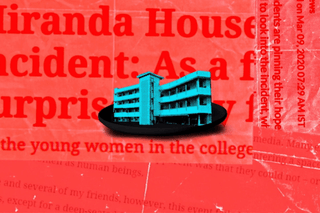
The Miranda House Incident Exposes the Cracks in Society’s Upbringing of Men
Men are socialized to fetishize and feel entitlement over women’s-only spaces.

Till 14th October 2022, Dhanya Mishra, a second-year student at Miranda House, University of Delhi (DU), always imagined her college as the one place in the world where she was safe. On that fateful day, however, things changed. A Diwali fest was being conducted when hordes of men entered Mishra’s college, many of them scaling the walls to do so. Once inside, they chanted sexist slogans and trespassed into classrooms. Reports of sexual harassment followed. “I was shocked, baffled, angry, to say the least. I did not imagine that all that could happen in an open DU fest, that too in a college like Miranda!” Mishra said, recounting the horrors of that day.
Horrific as it was, the incident at Miranda House was in no way unique or even unprecedented. For instance, just before the university closed down due to the pandemic in 2020, a very similar situation occurred in Gargi College, another DU women’s college. “These events are not new. Only that, with the advent of social media, it has become easier to record and report such incidents,” notes Nabanipa Bhattacharjee, Professor of Sociology at Shri Venkateswara College, DU.
These incidents point to how women’s colleges – envisioned as safe spaces that shun the male gaze within their premises – often ironically become sites for the ugliest of male fantasies to play out.
These spaces have been fetishized and exoticized by the Indian patriarchal society since their inception.
“You’ll find people like Amitabh Bacchan cracking jokes of how they waited on the bus stand near Miranda’s gate just to catch a glimpse of the girls there,” points out Shinjinee, a student from Miranda who was present on the campus during the Diwali Mela.
On the other side of this fixation lies a deep discomfort and stereotyping of women who occupy these spaces. A few months back, a matrimonial advertisement from the 1990s went viral on the internet. The ad singled out girls from Miranda House and the Lady Shri Ram College for Women, alongside women studying in the (co-ed) Jawaharlal Nehru University, asking them to not apply.
Briefly understanding the history of these colleges may help us understand this specific fascination with as well as an aversion to them. “Women-only academic spaces offered women the freedom to learn, engage, and socialize away from overt male presence though not entirely in the absence of patriarchal control,” explains Sneha Sharma, Assistant Professor of English Literature at Ramjas College, DU. “Even as women carried their class and caste consciousnesses to the classroom, these spaces were considered more liberatory and, as a result, most of these colleges earned the reputation of being ‘feminist’ spaces.” This reputation of being ‘feminist’ seems to drive the narrative around the graduates of the colleges as free-thinking and independent, which by extension make these women unfit for marriage, if only because she has been taught and trained to question instead of obey. Inversely, this also leads to them being perceived as having “loose” morals – and therefore fair play for exploitation.
This can be seen in a reply to the viral tweet of the men scaling the walls of Miranda House, which claimed that the men were just playing around, daring each other to climb the walls – “boys being boys.” It is not difficult to see that the thrill of these “dares” come from the desire to violate a safe space for women and flaunt masculinity for an adrenaline rush.
Related on The Swaddle:
Amid Unofficial Hijab Curbs, Karnataka Plans to Frame Guidelines for College Uniforms
Men’s desire to breach buildings that are specifically meant for women plays out as an extension of their conception of and control over the sexual act itself. A space populated entirely by women becomes an extension of the female body, and the mystique around these colleges becomes an extension of the mystique around vaginas and men’s desire to violate and own them.
Sharma too notes that “the forced entry of men on Diwali Mela is a sign of aggressive masculinity and the act is a case of sexual harassment, which must be read in terms of its legal definition as ‘an act of power.’”
To further understand this power thrill, we need to understand the social circumstances that build up to it, says Alphy Geever, Assistant Professor of Philosophy at a DU College.
Geever acknowledges that we do “have to look at this from the lens of criminality, in the sense that it is about men as a class, within a patriarchal setup, believing that they have certain liberties with women as a class.”
However, Geever goes on to say that directing our attention solely to criminality may prevent us from getting to the root cause and suggests that we also try to understand this phenomenon through the idea of curiosity and moral policing.
“If we go back to how schooling is done in our country, for instance, we find gender-based ways of segregating students. There are girls’ lines and boys’ in class assemblies. There are girls and boys who are not allowed to sit together on a bench. Of course, trans or non-binary people are not even included in this conception,” Geever explains, adding that this constant segregation and the absence of conversation around sex and sexuality restricts the interactions people have with members of other genders, generating a great deal of curiosity about their lives and lifestyles.
The men scaling the walls at women’s colleges, then, is one of the severely unhealthy ways of dealing with this curiosity, as are overly sexualized narratives surrounding Girls’ Hostels or Girls’ Common Rooms.
It is imperative here to note the role that there are also notions of purity and control at play here to maintain this culture of segregation. “There is the question – particularly in the case of women – of whether a person is polluted or whether they are pure and virgin,” explains Geever. Through this perspective of control – achieved often through constant segregation – women’s colleges themselves become a site to “protect” women, to keep them pure, unadulterated, and under control. Hence, beyond the doubling down of the male gaze, these places also come with their set of curfew timings, restrictions, and other forms of policing.
“It’s actually primitive to keep women all locked up together in one place – like a quarantine – under the pretext of their safety. It circles back to the idea that no matter what, simply being a woman is a vulnerable situation. It also ignores what many protesting against such primitive forms of ‘security’ have already pointed out – it is the men who should need policing for their behavior,” explains Geever.
Miranda House, notably, is one of the few colleges in DU without a curfew timing. This came as a result of a movement led by Pinjra Tod, a women’s collective centered around universities and colleges in Delhi. The movement seeks to break out of this idea of policing women and restricting their movement to supposedly keep them safe.
Related on The Swaddle:
Compulsory Sex Education Is the Only Way to Avoid Another #BoysLockerRoom
This constant anxiety about keeping women safe needs to be understood as a byproduct of not engaging or confronting the ways in which boys and men are brought up in society. As Bhattacharjee comments, “Men are entitled. They are grossly entitled. And parents too play a large role in it.” She explains how, when a student is accused of harassment, parents may often reply with phrases like, “It was not harassment, just some eve teasing,” or “the person’s intentions weren’t wrong.”
Bhattacharjee believes that “thorough counseling of the perpetrators” could be one way of dealing with these entitled men. Speaking from her experience of teaching in a co-ed college, she highlights that misogyny is universal. While the violence in women’s colleges may be a notch or two higher than usual, it isn’t entirely unique. Hence, the men – products of their circumstances and entitled upbringing – need to be counseled properly so that they realize the error of their ways. Sharma, too, believes in the need for gender sensitization in the college and university space.
A fortnight after what happened at Miranda House, the university issued guidelines for colleges to follow during fests and other events, suggesting that fewer students be allowed for such events. Geever calls these guidelines a “shock response,” adding that policing and restricting interaction with other people will only stun students’ own development.
Further, although the university’s approach is a response to the immediate security threats, it is not nearly adequate to address the root cause of the issue.
“This breach must be read not only as a stray act of aggression but also in terms of the dwindling of adequate provisions for gender sensitization and training in university spaces,” says Sharma.
“By treating it as a security issue and a matter of administrative control, the university has yet again failed to realize the need for long-term engagement on matters of gender sensitization in the (university) campus.”
Without actively involving the men on the campus (and the men outside of it), gender sensitization as an approach against misogyny will largely be ineffective, as it presently happens to be. Patriarchy has to be understood beyond just being a “women’s issue.” Geever highlights how gender sensitization cells in colleges, or classes on gender and sexuality, have a predominantly woman population. “As if it is the burden of solely women to speak about gender inequality in society. And this will remain women’s burden till they consciously choose to proclaim that they are stepping out of it.” The few men who populate these sessions and courses become heroes – easily co-opting the discourse to make it about how nice and great they are.
Further, “It is very easy to blame the men scaling the walls of Miranda House because they were caught on camera,” Geever comments, stressing that misogyny exists in many more subtle and invisible forms. Our culture of secrecy, segregation, and policing and control will only worsen the situation. The need, then, is to begin having these conversations with our children in a healthy and open manner from an early age and to minimize segregation between genders.
Misogyny, and the desire to breach women’s spaces, extend way outside the university space, and there is a need to engage with these issues on a holistic, societal scale. However, the onus of educating and engaging must not fall on these spaces exclusively – spaces created in the first place as a measure to deal with society’s inadequacies in raising its men. Achieving gender equality, after all, is not solely a women’s burden.
Sobhana is a second-year student at Miranda House, University of Delhi. She writes about gender, politics, and the environment. You can reach her on Twitter @sobhana__. Amlan is a Staff Writer at The Swaddle.
Related


The ‘Delhi Murder’ Isn’t a Cautionary Tale. Why Does the Media Turn It Into One?
